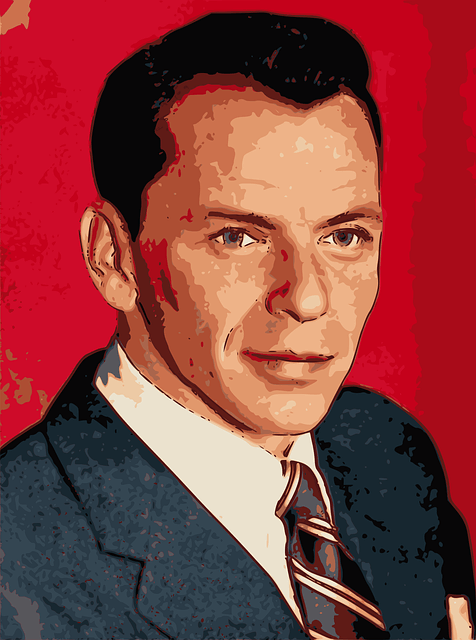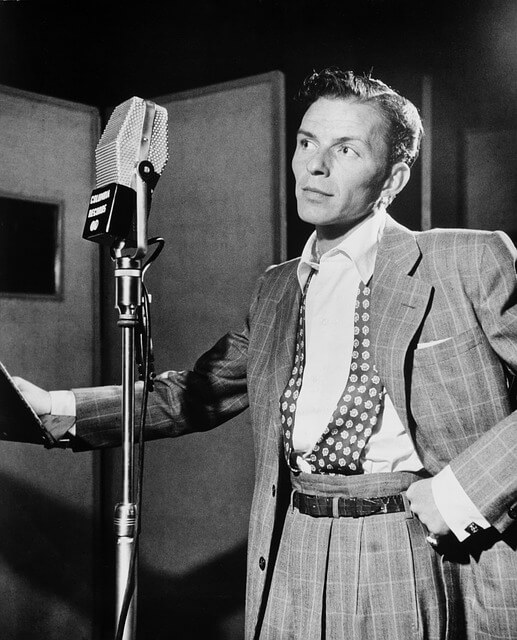Who was Frank Sinatra? Information about American music person Frank Sinatra life, biography, songs, movies, music career.
American singer and film actor (Hoboken, New Jersey, USA, December 12, 1915 – Los Angeles, California, May 14, 1998). His full name was Francis Albert Sinatra.
Frank Sinatra, through a long career and a very public personal life, became one of the most sought after artists in the entertainment industry; he is often hailed as the greatest American singer of popular music of the 20th century.

Source : pixabay.com
Sinatra’s father, Martin, was a part-time tavern owner and boxer, and his mother, Natalie, known to all as “Dolly,” was a dominant influence in both local politics and her son’s life and career. . Listening to Bing Crosby’s recordings, Sinatra was inspired as a teenager to choose popular singing as a vocation. He joined a local singing group that, like the Hoboken Four, won a talent show in 1935 on Major Bowes’ popular radio show “Amateur Hour.”
The group toured the country that year, but Sinatra was the only member with serious musical ambitions, and they soon disbanded. For the next several years, Sinatra sang with local dance bands and for remote radio broadcasts. In 1939, while singing and waiting tables at Rustic Cabin in Englewood Cliffs, New Jersey, he was discovered and hired by a trumpeter. Harry James, who had recently left the Benny Goodman Orchestra to start his own band.
Sinatra’s six-month tenure with James’s band resulted in 10 commercial recordings with the young singer. On songs like “From the Bottom of My Heart,” “My Buddy” and “Ciribiribin,” Sinatra’s warm baritone and sensitivity to lyrics show up well. The best known of the James-Sinatra sides is “All or nothing at all,” a failure in 1939 but a million sales when it was republished in 1943, after both men became stars. Sinatra’s reputation among musicians in the industry grew rapidly, and James politely released Sinatra from his contract when the singer received a more lucrative offer from the band’s leader, Tommy Dorsey, in December 1939. The 83 commercial recordings (thus as several surviving air controls) that Sinatra did with Dorsey’s gang from 1940 to 1942 represent his first major work.
Sinatra was greatly influenced by Dorsey’s trombone and strove to improve his breath control to emulate Dorsey’s continuous and uninterrupted melodic passages. It was also during this period that Sinatra demonstrated his mastery of both ballads and fast-paced numbers, and Dorsey’s arrangers: Axel Stordahl, Paul Weston, and Sy Oliver, soon adapted his arrangements to highlight his abilities. Sinatra. Often alongside singer Connie Haines, or with Dorsey’s vocal group The Pied Pipers (with future recording star Jo Stafford), Sinatra appeared on memorable sides such as “I’ll Never Smile Again”, “I’ll Be Seeing You “,” Without a song “and” Oh! Look at me now.”
By 1942, Sinatra’s fame had eclipsed Dorsey’s, and the singer yearned for a solo career, a risky adventure in the days when few big-band singers achieved success on their own. Dorsey enjoyed having such a popular performer in his band and was enraged when Sinatra expressed his desire to leave, despite Sinatra offering to stay with the band for another year. After months of bitter negotiations, Sinatra left the Dorsey organization in late 1942; within weeks, it was a cultural phenomenon. Almost the hysteria was sparked by Sinatra’s appearances at New York’s Paramount Theater in January 1943, and those crowds of screaming young fans, known as “bobby-soxers,” had not been seen since the days of Rudolph Valentino. The singer was soon nicknamed “Frankieboy”, “The Sultan of Swoon” and, more popularly, “The Voice”.

Source : pixabay.com
A strike by the American Federation of Musicians against major record companies reduced Sinatra’s record output for most of 1943-1944. His solo recording career for Columbia Records began in earnest in November 1944, when he made up for lost time by recording dozens of sides in a three-month period. Songs like “If You Are But a Dream”, “I fall in love too easily”, “Nancy” and its main theme at that time, “Put your dreams in the way”, are some of the first recordings in what would come to be known to fans as the “Columbia era” (1943-1952). His main arranger during these years was Axel Stordahl, who also left Dorsey in late 1942 to work exclusively with Sinatra. Stordahl’s spare string arrangements on beautiful recordings like “You Go to My Head” (1945), “These Foolish Things” (1945) and “That Old Feeling” (1947) defined the sound of the Sinatra years in Columbia. .
Sinatra’s success continued unabated until about 1948. In later years, he speculated that his sudden decline in popularity was due to his reluctance to change styles and evolve musically. He also garnered a great deal of negative press throughout 1947-1948. It was around this time that the public first read reports of his friendships with organized crime figures, and accounts were published in newspapers of Sinatra frolicking in Cuba with the likes of Lucky Luciano and Joe Fischetti, a prominent figure in the mafia. . There was also the widely reported incident and the resulting lawsuit, in which Sinatra struck out at gossip columnist Lee Mortimer, an action for which Sinatra received some vindication in later years when it was revealed that Mortimer had collaborated with the FBI to discredit Sinatra.
Whatever the cause, Sinatra began a five-year period of professional decline and personal depression. Years of singing up to 100 songs a day had taken their toll, and he lost his voice completely for several months in 1950 due to bleeding from his vocal cords. His divorce from his first wife, Nancy, in 1951 and his subsequent stormy marriage to actress Ava Gardner further damaged his reputation.
In addition, the then-new president of Columbia Records, Mitch Miller, cajoled Sinatra into recording several novel and banal tunes that compromised his artistic credibility. In 1952, his recording contract with Columbia expired and he was not renewed, he was fired by his talent agency, his network television show was canceled, and Sinatra was deemed a success. Ironically, despite Miller’s demands, several of Sinatra’s recordings from this period are now considered among his best, with shining examples such as “Mad About You”, “However”, “Birth of the Blues” and especially , his 1951 recording of “I’m a fool for wanting you.”
Sinatra appeared in a number of films throughout the 1940s, the best of which was the musicals in which he co-starred with dancer Gene Kelly. Of these, Anchors Aweigh (1945) and Take Me Out to the Ballgame (1949) are fun diversions, while On the Town (1949) is among the greatest film musicals. It was the acting, rather than the music, that precipitated Sinatra’s return in 1953. He pleaded with Columbia Pictures president Harry Cohn for the role of the tragic soldier and fighter, Maggio, in “From Here to Eternity” (1953). ), and agreed to work for scale. His performance was universally praised and earned him an Oscar for best supporting actor.

Source : pixabay.com
Sinatra became one of the leading movie stars of the 1950s and 1960s, and made excellent performances in quality films such as Suddenly (1954), Young at Heart (1954), The Man with the Golden Arm (1955; Academia Best Actor Award Nomination), Guys and Dolls (1955), The Joker Is Wild (1957), Pal Joey (1957) and Some Came Running (1958). The political thriller The Manchurian Candidate (1962) is perhaps Sinatra’s best film and features his best performance. With the possible exception of Bing Crosby, no other American artist achieved such a level of respect and popularity as a singer and actor. Though Sinatra is said to have stopped taking movies seriously after The Manchurian Candidate, due to his constant frustration with the tedious making process, his cinematic resume remains impressive. In later years, he was memorable in The Detective (1968) and in his last vehicle, The First Mortal Sin (1980).